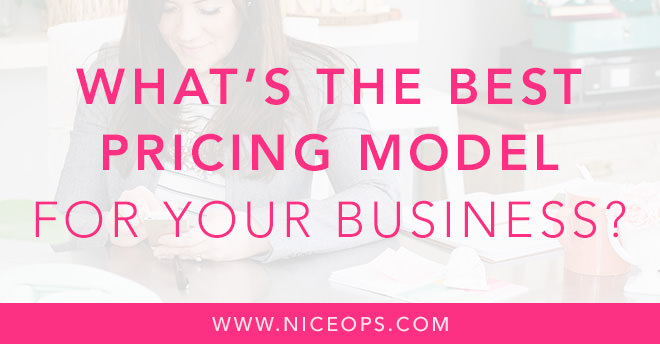One of my most favorite things to work with clients on is pricing. Why?
Yes, I do love the money and the numbers, but it’s more than than. You do know, counting money makes people happy, don’t you?
The real reason pricing means so much to me is because, when you nail your pricing magic starts to happen.
Suddenly, there’s less grind and way more glory on the road to building a business.
But pricing is tricky, tricky business for most of us. In this post we broke down how to figure out your pricing using market research along with pricing and revenue models. Which is an amazing start, but once you’ve got a handle on your numbers, you need to decide how you charge your clients.
⅔ of businesses are made up of service based businesses. It’s one of the trickiest to price for because we are putting a price on the time of people delivering services.
If you yourself run a service-based business, you’ve may have heard the saying “don’t trade hours for dollars”, which is advice I can stand behind, but only to a point. When people pay us, we’re trading something for that money. It may be energy, knowledge or something else, but there’s always an exchange going down when you get paid.
The key is choosing a pricing model that suits you and lets you exchange your thing for money in a way that makes you joyful and not resentful.
Here’s three pricing models to consider for your business:
Model #1: Charge by the Hour
This is probably the most common model as it’s clear cut and everyone can understand how a hourly rate of X for Y hours results in Z price. The charge by the hour model can work extremely well in many cases, and it doesn’t really deserve the bad rap it gets.
For a lot of people, this helps them ensure they get paid fairly for the time they put in and there’s no surprises for the client. Most of the contractors on my team charge me based on their hourly rate and a previously agreed upon set of hours. As a client, I can plan accordingly based on what’s required in a given month.
As a service provider, the key is for you to land on an hourly rate that ensures you’re profitable. Too many times people charge way too low of a rate and end up feeling marginalized or stretching out the hours on the invoice to get paid a little more. Find a price that’s fair and makes you feel like the exchange is equal.
On the flip side, you need to know what the market can handle. Being a $750/hour coach is all well and good if you can fill up your client roster, but if you’ve got no clients, you need to tether that hourly rate back to the current market reality.
2. Charge by the Project
Maybe charging by the hour isn’t your thing, so you may want to consider charging by the project. This can be done using an average number of hours to complete the project and then using your hourly rate to figure out the right price. Then you can add any additional costs related to providing that service into the project cost as well.
Project pricing can be extremely helpful in situations where you’re not quite sure what’s involved, but can create a defined scope of work. For example, if you’re a designer, you may have clients where it takes you a couple hours to create logo concepts, but with other clients, it may take 6 or more hours. Over time, that balances out based on an average of how long things actually take.
If you’re going to go with project pricing, take time upfront to agree on what’s included and what may require additional project fees. Scope creep is entirely likely if you’re using project pricing so being clear upfront can save you time and frustration down the line.
3. Charge Based on Value to the Client
Value-based pricing is a bit trickier but is a great option especially once you’ve got an established track record and are in demand. If your client lineup is full and you’re booked out for months to come, value-based pricing lets you charge a premium for your craft.
Like project pricing, you might charge a flat fee for your services or for a project. You may also adjust that pricing after you determine the project fee based on value offered or value of the offer to your client.
Let’s say you’re a copywriter who specializes in sales pages and you know there’s demand for your services, and there’s a limited number of copywriters in your niche. Assuming you’ve got a handle on your market and worked your revenue/profit targets, now you can determine how much value you’re delivering your clients.
If you work with clients who make $75,000 or more typically on their launches, you’re delivering immense value to their business, as they know your copy gets results.
Where a copywriter off the street may charge $1000, you may be able to charge $5000. This is why you have copywriters that charge rockstar prices like $30,000 for a sales page. When you deliver the goods, price accordingly!
When you’re at this level, the beauty of value-based pricing is that you have a golden opportunity to either work with fewer clients and make the same amount of money, or for you to dramatically boost your bottom line.
If you’re going to move to value-based pricing, pay attention to the feedback the market gives you so you can adjust over time, because the last thing you want to do is price yourself right out of business. Don’t forget to keep an eye on scope as well. Like project pricing, identify what is included or not included in any fixed fee project or flat rate project.
When it comes to these three pricing models, you may use them at different times or decide one isn’t the right fit for you. Regardless, the choice is yours.
I’d love to hear from you in the comments. What pricing model are you using right now? What’s been working and not working for you? Any tips to share with the Nice community below?
Bring it on!!!



